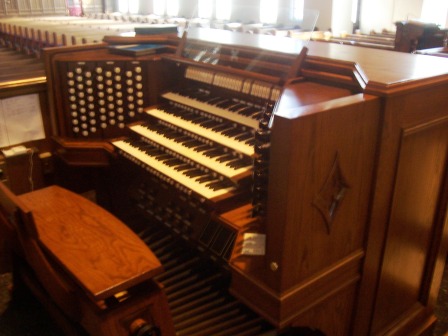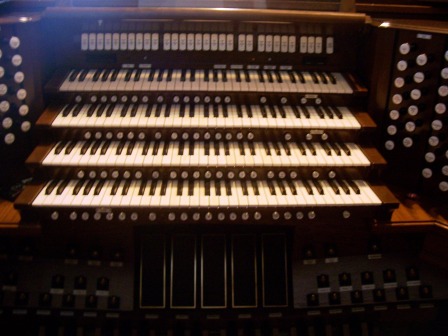The Skinner Organ at Grace Covenant Presbyterian Church
Grave Covenant Presbyterian Church is located on Monument Avenue at Stuart Circle. The organ that currently resides in the church is made from an Ernest M. Skinner design and was purchased from The Schantz Organ Company. Ernest M. Skinner, one of the most famous organ builders in the United States, grew up in the late 1800s and early 1900s in Clarion, Pennsylvania. Skinner struggled with his organ building business during the first several years, but he constructed extraordinary instruments and developed a large clientele. He is credited with developing new families of stops for the pipe organ. Skinner later formed a partnership with Arthur Hudson Marks, a millionaire chemist and organ aficionado, who bought an interest in the Ernest M. Skinner Company, which later was renamed the Skinner Organ Company. In 1928, the Skinner Organ Company reported sales of $1,427,897, which is the equivalent of $15,000,000 in 2003 dollars. Toward the end of Skinner’s career, many of his organs were being replaced with more “fashionable” instruments of the time. As a result, many of his organs have been removed or rebuilt, but the original organs built by Mr. Skinner are highly prized instruments.
 Grace Covenant is proud to have the third largest organ in Richmond. The previous organ had been in service since 1923, when the church building was constructed. When the instrument had begun to show its age after seven decades of use, the church decided to obtain a new organ. The process involved six phases and took almost a year to finish. The first phase was preparation, which involved identifying funding sources, determining how long it would take for the old organ to be removed and the new organ to be installed, and where the services would be held while the replacement process was taking place. The second phase involved the removal of the old organ, which took about a week. The third phase consisted of creating new space for the new organ pipes. This required cutting into cement walls for more space for additional pipes. In contrast to the prior organ for which all the pipes were visible, only the front row of the pipes for the new organ are visible from the sanctuary. The restoration and cleaning of the old pipes and building of the new pipes constituted the fourth phase. The console and casework also were created during this stage. The organ was built, played, and then taken apart before being delivered to the church in order to insure that a high quality, functioning organ would be delivered. The fifth phase was the actual installation of the Skinner Organ, the console, where the organ is played, and the casework of the organ. The sixth and final phase was the voicing, which entails making sure the pipes are set to produce the correct sound, a process that required approximately seven weeks to complete. Preparation began in March, 2005, and installation was completed the following December.
Grace Covenant is proud to have the third largest organ in Richmond. The previous organ had been in service since 1923, when the church building was constructed. When the instrument had begun to show its age after seven decades of use, the church decided to obtain a new organ. The process involved six phases and took almost a year to finish. The first phase was preparation, which involved identifying funding sources, determining how long it would take for the old organ to be removed and the new organ to be installed, and where the services would be held while the replacement process was taking place. The second phase involved the removal of the old organ, which took about a week. The third phase consisted of creating new space for the new organ pipes. This required cutting into cement walls for more space for additional pipes. In contrast to the prior organ for which all the pipes were visible, only the front row of the pipes for the new organ are visible from the sanctuary. The restoration and cleaning of the old pipes and building of the new pipes constituted the fourth phase. The console and casework also were created during this stage. The organ was built, played, and then taken apart before being delivered to the church in order to insure that a high quality, functioning organ would be delivered. The fifth phase was the actual installation of the Skinner Organ, the console, where the organ is played, and the casework of the organ. The sixth and final phase was the voicing, which entails making sure the pipes are set to produce the correct sound, a process that required approximately seven weeks to complete. Preparation began in March, 2005, and installation was completed the following December.
 The organ requires substantial upkeep as it usually needs to be tuned twice a year. Reguar tuning is necessary since the pipes shrink during the winter months and expand during the summer months. Tuning is usually an all-day project that requires two people. One person stands by the organ to strike every key while the other person is adjusting the pipes, pushing or pulling slightly the top metal part of the pipes.
The organ requires substantial upkeep as it usually needs to be tuned twice a year. Reguar tuning is necessary since the pipes shrink during the winter months and expand during the summer months. Tuning is usually an all-day project that requires two people. One person stands by the organ to strike every key while the other person is adjusting the pipes, pushing or pulling slightly the top metal part of the pipes.
Grace Covenant Presbyterian Church
1627 Monument Avenue
Richmond, VA 23220
( 804)-359-2463
Sources:
Grace Covenant Presbyterian Church staff
Profile prepared by Sarah Chumney
April, 2008
